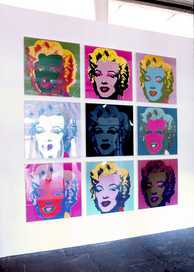
Pin Up Installation Tate Liverpool 2002
The definition of Pin-up is:
- A picture of a sexually attractive person, esp. when partially or totally undressed
- A person who has appeared in such a picture
- A photograph of a famous personality designed to be hung from a wall
Both artists and celebrities are in the business of image creation. Celebrities often manipulate their own image to attract fans whereas visual artists have traditionally produced desirable images for collectors to acquire and admire. This display of works from the Tate Collection charts the relationship between art, glamour and celebrity since the 1960s. It brings together a selection of paintings, prints and photographs by artists seeking to understand the importance of fame within our culture. All of the works are wall-based to reflect the format of pin-up posters. They are arranged into three groups Film Star, Pop Star and Model to reveal how representations of different celebrity types have developed over time.
Although prominent personalities have existed since records began – a flip through any history book will show flattering portraits of religious and state leaders – today's celebrities are more likely to be models than monarchs. As western society has become more secular and democratic the need for religious or royal icons has declined (with perhaps the exception of Diana, Princess of Wales). Yet our desire to create idols remains.
Celebrity as we now recognize it developed rapidly in the twentieth century, particularly in the 1940s and 1950s. During these years of post-war instability and regeneration, many ordinary people dreamed of a better world. They found solace in the perceived thrill and prosperity of American life, as personified by the stars of new popular forms of entertainment such as Hollywood films, rock 'n' roll music and pin-up magazines.
The project not only revealed the huge variety of celebrities, past and present, which are idolised today, but also the complex nature of fan worship. Sexual attraction, admiration of a celebrity's personal values, their talent and material success plus critical and public acclaim, were all cited as reasons for devotion. The project also revealed the profound importance that images of the celebrity played within the lives of the fans. In our largely secular society this raises issues over the convergence of celebrity worship and religious worship. Fans often build their own 'reliquaries' of their idols: one participant in the project described a display dedicated to their idol as a 'shrine'. The items that fans display and collect often have a special and personal meaning, and can serve to reduce the distance between themselves and the celebrity.

